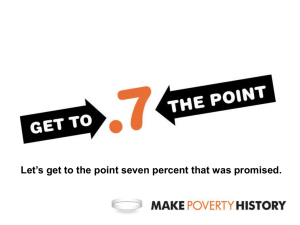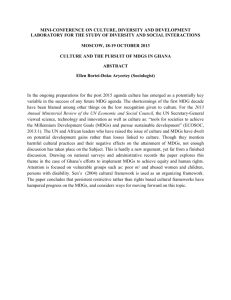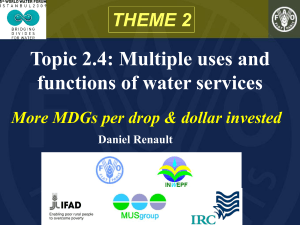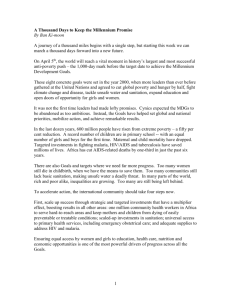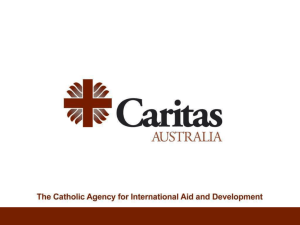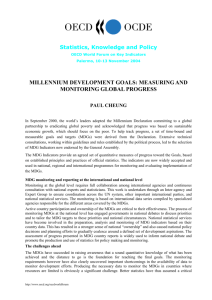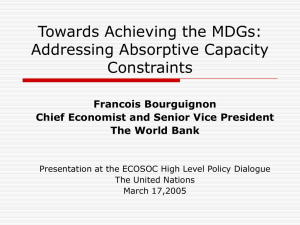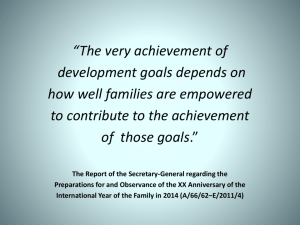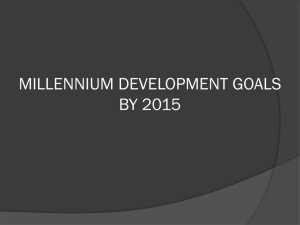THE MILLENNIUM DEVELOPMENT GOALS: PRACTICAL TARGETS FOR REDUCING EXTREME POVERTY
advertisement
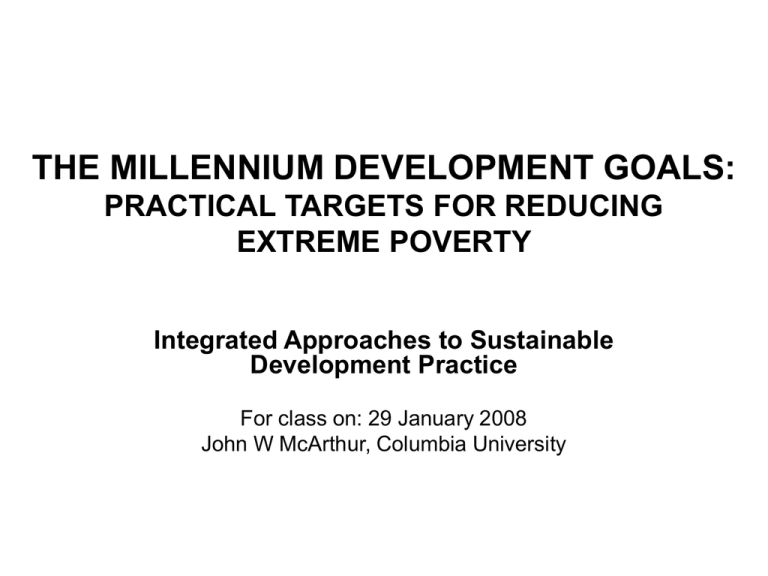
THE MILLENNIUM DEVELOPMENT GOALS: PRACTICAL TARGETS FOR REDUCING EXTREME POVERTY Integrated Approaches to Sustainable Development Practice For class on: 29 January 2008 John W McArthur, Columbia University TODAY’S FIVE KEY TOPICS • WHAT ARE THE MDGs & WHY ARE THEY IMPORTANT? • WHAT IS THE STATUS OF THE MDGs? • WHY ARE THERE SHORTFALLS? • WHAT PRACTICAL STEPS CAN BE TAKEN? • WHAT WILL IT COST? THE MILLENNIUM PROMISE We will spare no effort to free our fellow men, women and children from the abject and dehumanizing conditions of extreme poverty, to which more than a billion of them are currently subjected. - Millennium Declaration, September 2000 THE MILLENNIUM DEVELOPMENT GOALS 1. Eradicate extreme poverty and hunger 5. Improve maternal health 2. Achieve universal primary education 6. Combat HIV/AIDS, malaria and other diseases 3. Promote gender equality and empower women 7. Ensure environmental sustainability 4. Reduce child mortality 8. Develop a global partnership for development [VIDEO] TODAY’S FIVE KEY TOPICS • WHAT ARE THE MDGs & WHY ARE THEY IMPORTANT? • WHAT IS THE STATUS OF THE MDGs? • WHY ARE THERE SHORTFALLS? • WHAT PRACTICAL STEPS CAN BE TAKEN? • WHAT WILL IT COST? GLOBAL MAP OF EXTREME POVERTY: INFANT MORTALITY AND % UNDERWEIGHT Source: UN Millennium Project/CIESIN, 2005 Average real GDP per capita growth (PPP$2000) Regional Economic Growth Since 1980 8% 6% 4% 1980-2004 1990-2004 2% 0% -2% East Asia Latin & Pacific America & Caribbean Middle East & North Africa South Asia SubSaharan Africa Source: [ ] Population Share in Extreme Poverty, 1981-2004 70 % living under $1/day 60 MDG Reference Date South Asia (1990) 50 East Asia & Pacific 40 Sub-Saharan Africa 30 Latin America & Caribbean 20 Middle East & North Africa 10 Europe & Central Asia 0 1981 1984 1987 1990 1993 1996 1999 2002 2004 Source: [ ] Distribution of $1/day poverty by region, 1981-2004 1600 Middle East & North Africa Population (millions) 1400 Latin America and Caribbean 1200 Europe and Central Asia 1000 800 East Asia Pacific 600 400 South Asia 200 Sub-Saharan Africa 0 1981 1990 2004 Source: Chen and Ravallion 2007 Prevalence of undernourishment (%) Hunger MDG 35 30 25 20 1992 15 2003 10 5 0 East Asia & Pacific Europe & Central Asia Latin Middle East South Asia America & & North Caribbean Africa Source: [ SubSaharan Africa ] Primary school completion rate (%) Education MDG 100 90 80 70 60 50 40 30 20 10 0 1990 2004 East Asia Europe & Latin & Pacific Central America & Asia Caribbean Middle East & North Africa South Asia Source: [ SubSaharan Africa ] Deaths per 100,000 live births Maternal mortality MDG 1000 800 600 2000 400 200 0 East Asia & Pacific Europe & Central Asia Latin Middle East South Asia America & & North Caribbean Africa Source: [ SubSaharan Africa ] Population without access to improved water source (%) Water MDG 60 50 40 1990 30 2004 20 10 0 East Asia & Pacific Europe & Central Asia Latin America & Caribbean Middle East & North Africa South Asia Source: [ SubSaharan Africa ] Under-5 deaths per 1,000 live births Child Mortality MDG 200 175 150 125 1990 100 2005 75 50 25 0 East Asia Europe & Latin & Pacific Central America & Asia Caribbean Middle East & North Africa South Asia Source: [ SubSaharan Africa ] Source: JD Sachs Source: [ ] GLOBAL MAP OF EXTREME POVERTY: INFANT MORTALITY AND % UNDERWEIGHT Source: UN Millennium Project/CIESIN, 2005 TODAY’S FIVE KEY TOPICS • WHAT ARE THE MDGs & WHY ARE THEY IMPORTANT? • WHAT IS THE STATUS OF THE MDGs? • WHY ARE THERE SHORTFALLS? • WHAT PRACTICAL STEPS CAN BE TAKEN? • WHAT WILL IT COST? FOUR REASONS FOR SHORTFALLS • Governance failures • Areas of specific policy neglect • Poverty traps • Pockets of poverty Source: UN Millennium Project. 2005. THE IMPORTANCE OF AGRICULTURAL PRODUCTIVITY Cereal Yield, 1961-2004 5,000 4,500 East Asia & Pacific 4,000 3,000 Latin America & Caribbean 2,500 South Asia 2,000 Sub-Saharan Africa 1,500 1,000 500 2003 2000 1997 1994 1991 1988 1985 1982 1979 1976 1973 1970 1967 1964 0 1961 kg/hectare 3,500 Source: World Bank World Development Indicators 2005 GLOBAL DISTRIBUTION OF DROUGHT RISK (mortality) Source: [ ] ECOLOGICAL FACTORS CONDUCIVE TO MALARIA Source: Kiszewski et al., AJTMH, 2004 HUMAN VULNERABILITY INDEX: Agriculture, Transport & Malaria risk Source: [] TODAY’S FIVE KEY TOPICS • WHAT ARE THE MDGs & WHY ARE THEY IMPORTANT? • WHAT IS THE STATUS OF THE MDGs? • WHY ARE THERE SHORTFALLS? • WHAT PRACTICAL STEPS CAN BE TAKEN? • WHAT WILL IT COST? BASIC CONCEPTS: GROWTH, CAPITAL ACCUMULATION & THE MDGs Source: UN Millennium Project. 2005. THE MDGs REQUIRE INTEGRATED STRATEGIES ACROSS SECTORS education water agricultural productivity health environmental management infrastructure gender equality PRACTICAL PROBLEMS PROBLEM (e.g.) • Low food yield • Malaria • AIDS • Maternal mortality • Low primary enrolment • Lack of physical access to markets PRACTICAL PROBLEMS => PRACTICAL SOLUTIONS PROBLEM (e.g.) INTERVENTION (e.g.) Low food yield Fertilizer, seeds, water Malaria Bednets, ACTs, spraying AIDS Anteretrovirals, condoms Maternal mortality Emergency obstetrical care Low primary enrolment Abolish school fees, introduce school meals, train teachers Lack of physical access to markets Roads, ports THE IMPORTANCE OF AGRICULTURAL PRODUCTIVITY Cereal Yield, 1961-2004 5,000 4,500 East Asia & Pacific 4,000 3,000 Latin America & Caribbean 2,500 South Asia 2,000 Sub-Saharan Africa 1,500 1,000 500 2003 2000 1997 1994 1991 1988 1985 1982 1979 1976 1973 1970 1967 1964 0 1961 kg/hectare 3,500 Source: World Bank World Development Indicators 2005 THE ROLE OF INPUTS FOR AGRICULTURE Fertilizer Use, 1961-2003 East Asia & Pacific 2,000 Latin America & Caribbean 1,500 South Asia 1,000 Sub-Saharan Africa 500 0 19 61 19 65 19 69 19 73 19 77 19 81 19 85 19 89 19 93 19 97 20 01 100g/arable hectare 2,500 Source: World Bank World Development Indicators 2005 EARLY SUCCESS IN MALAWI Source: [ ] THE MDGs ARE FEASIBLE Countries can break out of poverty if: 1. Broad-based integrated investments are implemented – at scale – in known practical technologies for health, education, agriculture, infrastructure, and environmental management 2. Sound policies and governance are in place, including good economic management 3. Improved market access bolsters economic progress But there is no “magic bullet” THE MDGs REQUIRE GROWTH AND INVESTMENT Growth is necessary, but not sufficient, for MDGs • Some MDGs require direct investments regardless of economic growth (e.g. maternal mortality, environmental sustainability) • Reaching the poor & reducing inequality requires direct investments in people, infrastructure & environment AND Public investments in the MDGs are critical for growth • Private sector-led growth requires minimum standards in health, education, infrastructure • Direct investments must complement good economic policies 5 CORE ELEMENTS OF AN MDG-BASED STRATEGY 1. Ambition: Aims are at least as ambitious as MDG targets for 2015 2. Scope: The range of sectors identified is broad enough to achieve all the MDGs 3. Practicality: For each sector, the strategy is based on a detailed, bottom-up assessment of practical needs 4. Timeline: The medium term strategy is nested in a 10-year framework 5. Financing: The financing is aligned with needs TODAY’S FIVE KEY TOPICS • WHAT ARE THE MDGs & WHY ARE THEY IMPORTANT? • WHAT IS THE STATUS OF THE MDGs? • WHY ARE THERE SHORTFALLS? • WHAT PRACTICAL STEPS CAN BE TAKEN? • WHAT WILL IT COST? $ per capita (USD 2002) Source: [ ] $ billions (USD 2002) SOURCES OF FINANCE: EXAMPLE OF GHANA Source: [ ] CURRENT GLOBAL FINANCE EFFORT Source: [ ] UNPACKING THE NUMBERS: TODAY’S SUPPORT TO AFRICA Source: OECD-DAC, 2006 MILLENNIUM VILLAGES Source: JW McArthur Source: C Bahadur Source: JD Sachs Source: JW McArthur WHERE WE STAND WITH 7 YEARS TO GO Are we on course to look back, in 2015, and say that no effort was spared? So far the record is mixed. - Kofi Annan, August 2006
